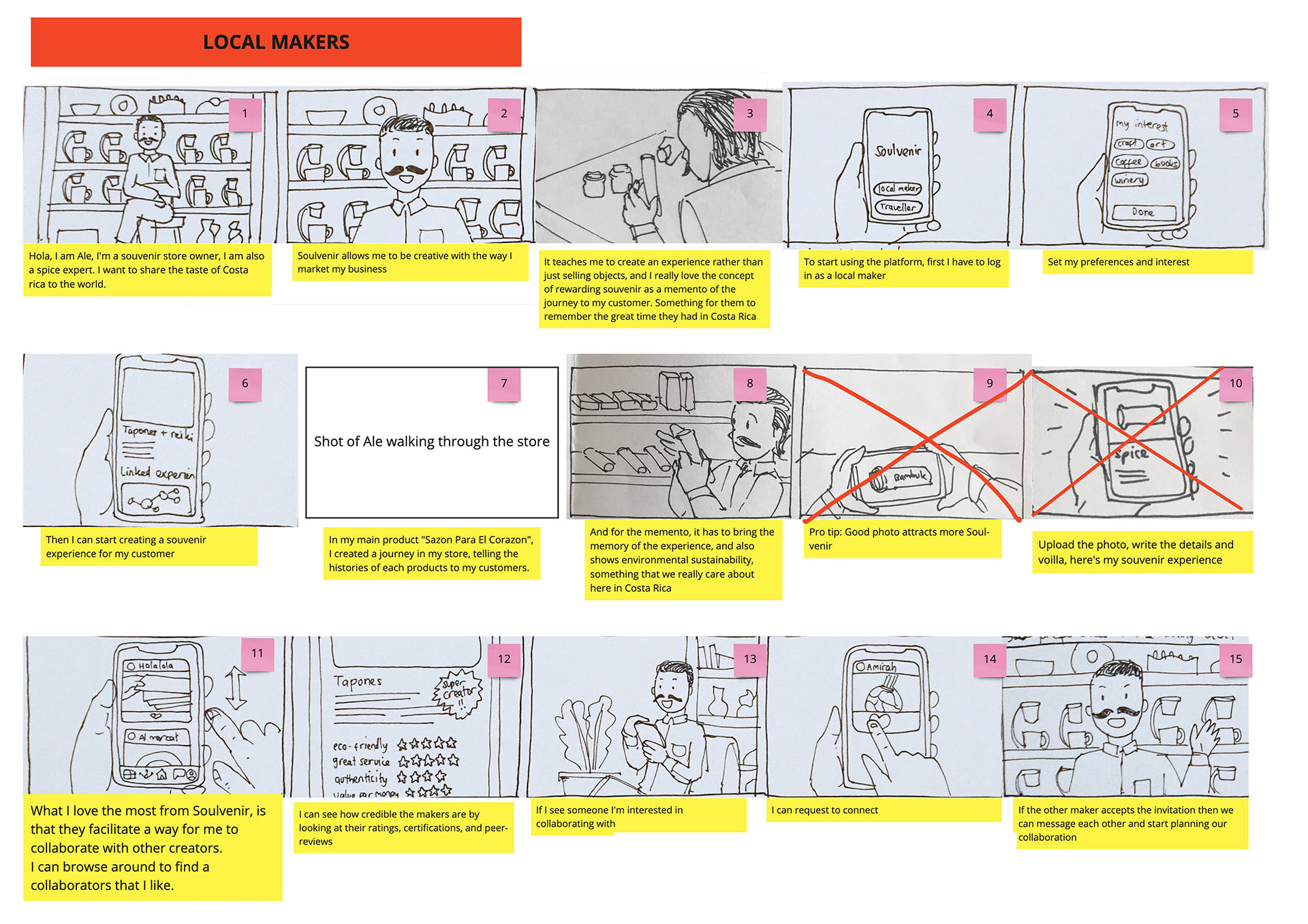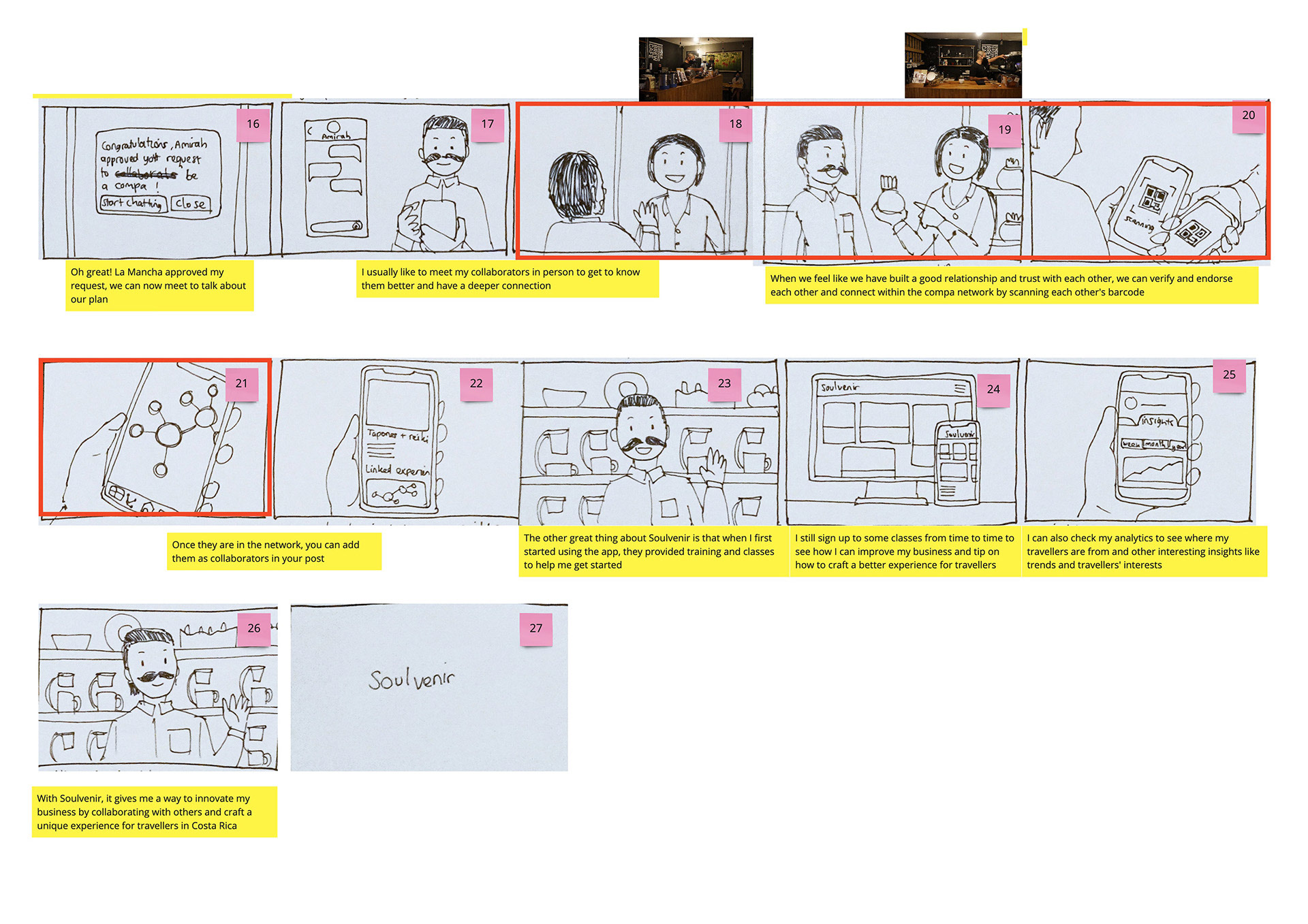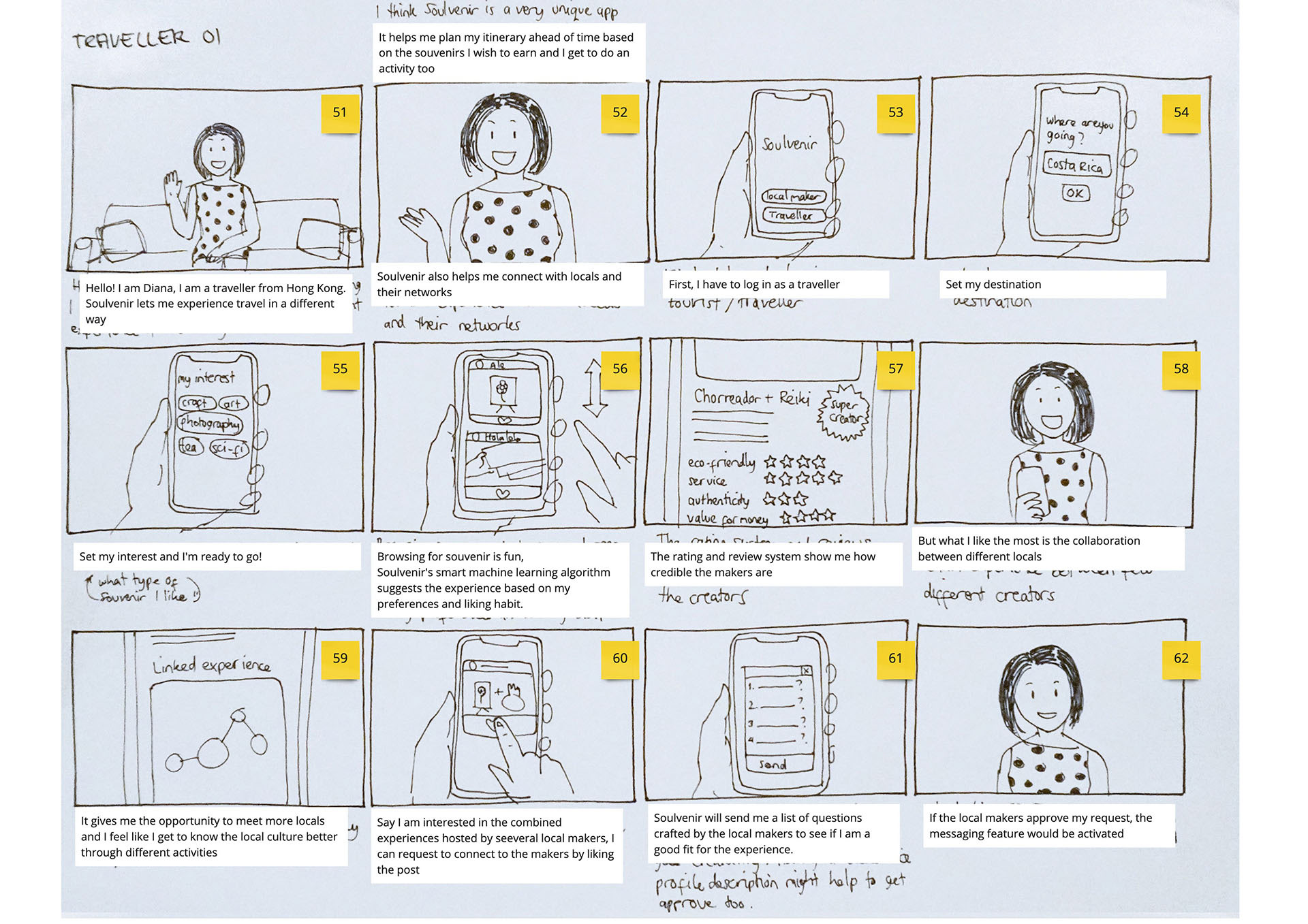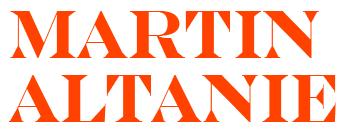Type: Service Design, Product Design
Role: Research, Concept, Prototyping, Video Storytelling
Team: 4 Designers, plus local stakeholders
Timeline: 3-week service design sprint
Institution: Copenhagen Institute of Interaction Design (CIID)
Location: Costa Rica, 2020
🔍 Executive Summary
Soulvenir is a service concept that reimagines tourism in Costa Rica as a deeply relational and sustainable ecosystem. By connecting local makers with travelers through curated experiences and authentic souvenirs, we designed a system that strengthens local economies, preserves culture, and fosters meaningful exchanges.
🧠 Context & Challenges
Costa Rica’s tourism industry is a major economic driver to the country's GDP, but the COVID-19 pandemic exposed its fragility: travel stalled, local makers struggled, and cultural connections were at risk.
We asked:
How might tourism become more resilient and life-centered while simultaneously expanding the economic growth of Costa Rica?
How might tourism become more resilient and life-centered while simultaneously expanding the economic growth of Costa Rica?
Through our research with Costa Rica tourism industry leaders, local makers, and travelers who have been to Costa Rica, we discovered:
- Travelers crave authentic and tangible local experiences.
- Travelers look for ways to share their travel stories, and souvenirs able to extend stories beyond time and space.
- Local artisans (makers) have limited digital presence and resources to market their products. While makers acknowledge the community is hyperconnected, more collaboration is desired but there isn’t an easy way to do so.
These insights shaped a reframed design brief: build a service that empowers local makers, connects them with travelers, and fosters cross-cultural collaboration.
💡 DESIGN SOLUTION
Core Concept:
‘Soulvenir’ is a service that matches local makers and travelers through local experiences and products, while providing opportunities for local businesses to collaborate with each other.
Soulvenir suggests tailored activities for travelers based on their interests, hosted by local makers and their connections in the Compa (‘friends’ in Costa Rican Spanish) Network. Travelers receive locally produced souvenirs at the end of each experience.
Through sharing knowledge, Soulvenir allows local makers and travelers to connect, providing cross-cultural (locals to travelers) and multi-disciplinary (makers to makers) exchange that shares the culture and strengthens resilience within the tourism ecosystem in Costa Rica.
Key Features - For Travelers
Tailored Experiences
Travelers receives recommendation based on interests, not irrelevant generic tours.
Hyper-connected Local Experiences
Travelers are introduced to the local network, and get to experience how locals interact with each other in their true local fashion.
Digital Twin
Travelers can log their souvenirs as mementos by scanning the Soulvenir after the experience, which also prompts travelers to leave a feedback for the local makers.
Key Features - For Local Makers
Find and Connect
Map-based interface shows local makers their Compa Network, allowing them to see potential collaborators around them.
Let’s Talk!
Good relationships and collaborations happen when people trust each other.
Makers can establish connections with a Compa by validating a physical code, encouraging an in-person meeting to discuss the collaboration.
Makers can establish connections with a Compa by validating a physical code, encouraging an in-person meeting to discuss the collaboration.
Show Me The Numbers
Monthly reports and other analytics help local makers understand their customers and their business better.
Continuous Training
Certificates and badges can be earned through attending workshops such as business operations and sustainability, to show makers’ commitment to the Compa Community and environment.
🔬 DESIGN PROCESS
Research & Discovery
What did we want to learn?
Our objective was to study the tourism ecosystem in Costa Rica and uncover the needs of both travellers and local business owners, as well as how COVID-19 is impacting tourism in the community.
Our objective was to study the tourism ecosystem in Costa Rica and uncover the needs of both travellers and local business owners, as well as how COVID-19 is impacting tourism in the community.
What did we do?
We drew insights from both travellers who have been to Costa Rica, current travellers, and local makers to learn about their desires and challenges, supplemented by literature review on the future of tourism post COVID-19.
We drew insights from both travellers who have been to Costa Rica, current travellers, and local makers to learn about their desires and challenges, supplemented by literature review on the future of tourism post COVID-19.
Methods:
- In-depth interviews
- Site visits
- Intercept interview
- Social listening
- Literature review
Tools:
- Ecosystem map
- Personas
- User journey map
- In-depth interviews
- Site visits
- Intercept interview
- Social listening
- Literature review
Tools:
- Ecosystem map
- Personas
- User journey map
1. ECOSYSTEM MAPPING
We started the research by doing ecosystem mapping of the tourism ecosystem in Costa Rica, to map out potential areas for further exploration.
2. DESK RESEARCH
Concurrently we also reviewed some literature on the impact of COVID-19 on tourism and identified three opportunity areas based on UN’s recommendations:
- Embracing local values
- Advancing digitalization of the tourism ecosystem
- Promoting coordination and partnerships to build resilience
- Advancing digitalization of the tourism ecosystem
- Promoting coordination and partnerships to build resilience
3. SOCIAL LISTENING
To get a broad look at the souvenir offerings in Costa Rica, we created Facebook post in a Costa Rica expat group asking for recommendations. We learned that:
- There’s a wide range of souvenirs from handcrafted wooden gifts to machete.
- Coffee related merchandise is the most popular souvenir by far.
- Local produce is recognised for its quality.
- Coffee related merchandise is the most popular souvenir by far.
- Local produce is recognised for its quality.
4. INTERCEPT INTERVIEW
We hit the streets of San José and interviewed some tourists there. We did some quick card sorting activities to understand their expectations and experience as a tourist in Costa Rica. It was a challenging task given the COVID travel restrictions and San José not being a tourist destination.
5. IN-DEPTH INTERVIEW
We spent 9 hours conducting in-depth interviews to explore:
- Travelers | Travel goals and travel process, from planning through execution
- Local businesses | Their wants and challenges
- Tourism experts | Overview of the challenges and trends in the tourism sector in Costa Rica
- Travelers | Travel goals and travel process, from planning through execution
- Local businesses | Their wants and challenges
- Tourism experts | Overview of the challenges and trends in the tourism sector in Costa Rica
6. PERSONAS CREATION
Having conducted our in-depth interviews with local makers and traveller, we consolidated our findings into personas and map out their journeys through a transaction (from pre-sales to post-sales) for makers and travel experience (from planning to post travel) for travellers.


Insights from data synthesizing
Reframed Brief
How might we leverage Costa Rica’s hyper-connectivity to connect travellers and local communities?
Opportunity Areas
What opportunity areas did we identify?
1. Creating personalized experiences for travelers
Travelers look for recommendations to find authentic experiences that best suit their interests, and rely on contextual information (e.g. stories and anecdotes) to assess their options.
Travelers look for recommendations to find authentic experiences that best suit their interests, and rely on contextual information (e.g. stories and anecdotes) to assess their options.
2. Connecting travelers with locals
Travelers enjoy meeting locals, casual encounters make the travel experience feel personal and authentic.
Travelers enjoy meeting locals, casual encounters make the travel experience feel personal and authentic.
3. Innovating and sustaining local businesses
With Costa Rica’s hyperconnected network, local businesses want to form partnerships with and learn from other businesses but there isn’t an easy way to do so.
With Costa Rica’s hyperconnected network, local businesses want to form partnerships with and learn from other businesses but there isn’t an easy way to do so.
Brainstorming
Based on our research insights, we brainstormed on a list of prompts and collated our ideas. The two themes that intrigued us were: extending the travel experience through souvenirs and showing the lives of Costa Rican people through daily objects and experiences.
Low Fidelity Prototype
Exploring how we could materialise our concepts, we defined the values and key features we wanted for our service to provide for both local makers and travellers. We used storyboarding to construct a narrative to imagine how this service would be used in context. We then created wireframes of the key features for our low fidelity paper prototype.
LOCAL MAKERS
Adding a connection to the Compa network by scanning a QR code
Adding a registered Compa to a collaborate on crafting an experience
TRAVELERS
Local makers getting a notification when travellers indicate their interest
Chat function is activated only if there is mutual interest from the local makers
Co-Creation and User Testing
What did we want to find out?
With our prototypes, we conducted six hours of co-creation and testing sessions with a traveller, a local maker, and two subject matter experts, to understand how different touch points in the service match with users’ motivations.
With our prototypes, we conducted six hours of co-creation and testing sessions with a traveller, a local maker, and two subject matter experts, to understand how different touch points in the service match with users’ motivations.
Methods and tools
Think Aloud | After presenting the general overview of the service, without showing the prototype we asked participants to describe how they would imagine the service to look like.
Roleplaying | We then introduced the prototype and asked the participants to guide us through how they would use it in specific scenarios, followed with questions on functionality and interactions to find out which features they would like to add or remove.
Contextualize | Following a quick debrief, we asked participants to imagine how this service would change their experience pre, during, and post travel (for travelers) / transaction (for local makers).
Insights from the sessions
Overall, both travelers and local makers saw the value from the prototypes.
Our maker participant was particularly excited about the prospects of the positive externalities generated through communal collaboration and using the service as a tool to build connections to their customers.
Our maker participant was particularly excited about the prospects of the positive externalities generated through communal collaboration and using the service as a tool to build connections to their customers.
‘This really made me think about how I can partner with other businesses to create something new together.’ — Local Maker
One thing that was mentioned during our co-creation sessions was that local artisans often feel the travelers and tourists do not respect their space and act in a way that is disrespectful. Local makers also noted they would like more help with understanding their customers and how to operate their business in a sustainable way.
Finalizing The Concept
Based on the feedback from the co-creation and testing sessions, we added a screening function for local makers to filter out travelers they deem as incompatible, so travelers will not be able to connect with them unless the request is approved by makers.
To provide more support for local businesses, we added an insights and analytics section for local makers, as well as offline workshops for ongoing training and development.
We created service blue print to details the interactions, and then made a storyboard to shoot the concept video.
To provide more support for local businesses, we added an insights and analytics section for local makers, as well as offline workshops for ongoing training and development.
We created service blue print to details the interactions, and then made a storyboard to shoot the concept video.




Potential Next Steps
Given the limited time (three weeks) and the circumstance (travel restrictions owing to COVID-19), we would have liked to test with more travelers. Some potential next steps to explore:
- Spanish version for local makers and intermediary translation services during the experience
- Collaborate with Souvenir Museum for a local artisan outreach programme
- Develop a feasible business model that is fair amongst local collaborators
- Explore possibilities for small group traveling (up to 3)
- Virtual experiences in case of future travel restrictions
🌟 Impact & Reflection
Impact
Even though Soulvenir was a conceptual project, it created real value through mindset shifts and community engagement. Throughout our interviews and co-creation workshops, local makers shared that the project helped them rethink what collaboration could mean, not just transactional exchanges, but creative partnerships rooted in shared identity and cultural pride. Many told us it encouraged them to imagine new ways of running their businesses, building resilience, and exploring collaborations they hadn’t considered before.
Reflection
Soulvenir was a formative project that strengthened my practice as a product and service designer. It reminded me that meaningful change often begins not with polished deliverables, but with iterative prototypes and early co-creation with stakeholders.
Working through both low- and high-fidelity prototypes helped us validate the core value of Soulvenir early. The simple paper prototypes quickly exposed usability gaps and clarified what resonated emotionally with users, while the high-fidelity flow allowed stakeholders to clearly picture how the service could work in real life. These iterations not only strengthened the concept but also shifted participants’ perspectives on what meaningful cross-business collaboration could look like.
Co-creation remains essential. Working directly with stakeholders reminded me that successful service design emerges from shared ownership. The prototype sessions were not “tests”, they were collaborations that expanded what the service could become.
Soulvenir reinforced a core belief: good design isn’t only about delivering a solution, it’s about helping people imagine a better version of their world. And sometimes, all it takes is the right prototype to unlock that moment.
Special Thanks
Priscilla Aguirre, Thikshan Arulampalam, Alejandro Castro, Ana Castro, Claudio Corrales, Ubaldo Andrea Desiato, Anna Hartly, Alberto Font, Matthew Giffen, Juan José Bolaños Herrera, Melissa Jiménez, Michelle Kwok, Simona Maschi, Mónica Mendoza, Stephanie Monterrosa, Yara Mourelo, Lidia Sancho, Liliana Tagini, Stephanie Yong

